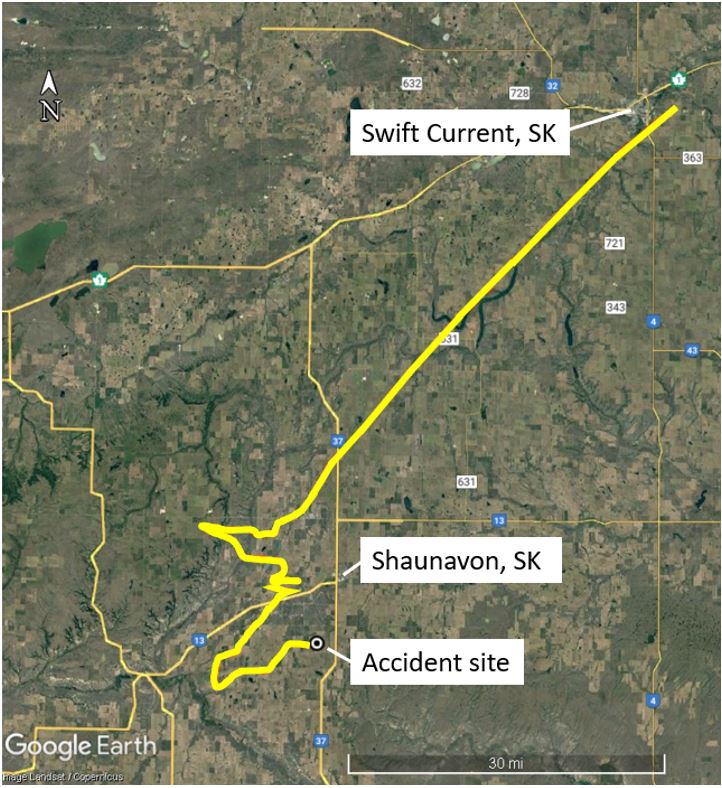Collision with obstacle
Airborne Energy Solutions Inc.
Cessna 172, C-GZLU
Shaunavon, Saskatchewan, 6 NM SSW
The Transportation Safety Board of Canada (TSB) investigated this occurrence for the purpose of advancing transportation safety. It is not the function of the Board to assign fault or determine civil or criminal liability. This report is not created for use in the context of legal, disciplinary or other proceedings. See Ownership and use of content. Masculine pronouns and position titles may be used to signify all genders to comply with the Canadian Transportation Accident Investigation and Safety Board Act (S.C. 1989, c. 3).
History of the flight
On 18 September 2022, the Airborne Energy Solutions Inc. Cessna 172 aircraft (registration C‑GZLU, serial number 17269719) was conducting a visual flight rules (VFR) flight consisting of multiple legs from Swift Current Airport (CYYN), Saskatchewan, to Estevan Regional Aerodrome (CYEN), Saskatchewan. The purpose of the flight was to gather electronic data on pipeline infrastructure for a client along a predetermined route that extended southeast of Shaunavon, Saskatchewan, then eastward to Estevan.
The aircraft departed CYYN at 0827Footnote 1 with 2 pilots on board.Footnote 2 At approximately 1003, the aircraft struck a communications tower approximately 6 nautical miles south-southwest of Shaunavon (Figure 1). The aircraft’s last recorded position on its flight tracker (at 1001:30) was 1.2 nautical miles west-northwest of the communications tower at an altitude of 3741 feet above sea level (ASL), which was 572 feet above ground level (AGL). The aircraft was destroyed. Both pilots were fatally injured. The aircraft’s 406 MHz emergency locator transmitter was destroyed on impact and no signal from it was received by the search and rescue satellite system.
Pilot information
The pilot flying, who occupied the left seat at the time of the occurrence, held a Canadian commercial pilot licence that had been issued on 14 September 2021. His licence was endorsed for single- and multi-engine aircraft. He held a valid Category 1 medical certificate, which had a restriction stating that “glasses must be worn.” He also held a Group 1 instrument rating. Records indicate that he had accumulated a total of 355 hours of flight time, 77 of which were on the Cessna 172 for Airborne Energy Solutions Inc. Records also indicate that he was well rested before the flight. According to information gathered during the investigation, there was no indication that the pilot’s performance was affected by medical factors.
The other pilot, who was monitoring the captured electronic data and assisting with navigation duties from the right seat of the aircraft, also held a Canadian commercial pilot licence. He had accumulated a total of 536 hours of flight time, 529 of which were on the Cessna 172.
Communications tower
The height of the communications tower was 3840 feet ASL, or 440 feet AGL. It was marked and lit in accordance with the Canadian Aviation Regulations.Footnote 3 The tower was also depicted on the Regina VFR Navigation Chart (Figure 2). A VFR Navigation Chart is used by pilots flying in accordance with VFR and illustrates obstacles and other navigational information. The investigation was unable to determine if the pilots had consulted the chart while flight planning or during the flight.
Client-specified flight parameters
The client’s aerial service provider job form listed several flight parameters to be followed while conducting flight operations. Among them was a specified flight height of 550 feet AGL (±50 feet). The aircraft was equipped with an altimeter, which indicates the aircraft’s altitude in feet ASL; however, it was not equipped with instrumentation that indicates the aircraft’s height in feet AGL.
Impact and wreckage information
The occurrence aircraft was travelling on a track of 88° true (T) when it struck the communications tower approximately 25 feet below the tower’s highest point. A 4-foot section of the aircraft’s right wing was shorn off and was discovered at the base of the tower. The fuselage then travelled approximately 240 m on a track of 174°T, before impacting the ground. A post-impact fire ensued, which consumed most of the remaining fuselage.
Weather information
The aerodrome forecast (TAF) for CYYN, issued at 0540 and valid from 0600 until 1800 on 18 September 2022, indicated the following from 1000:
- Winds variable at 3 knots
- Visibility greater than 6 statute miles
- Scattered cloud layer at 25 000 feet AGL
The automatic aerodrome routine meteorological report (METAR AUTO) for CYYN issued at 1000 indicated the following:
- Winds from 360°T at 5 knots
- Visibility of 9 statute miles
- Clear sky
- Temperature 12 °C, dew point 5 °C
- Altimeter setting 29.93 inches of mercury (inHg)
The graphic area forecast for the occurrence area, valid from 0600, indicated clear sky conditions with visibilities greater than 6 statute miles.
Weather was not considered to be a factor in this occurrence.
Sun position
Sunrise at Shaunavon on 18 September 2022 occurred at 0654. The sun’s position at the time of the occurrence would have been rising in the east. Solar position calculations indicate that the solar azimuth was 125°T (37° right of the aircraft’s track of 88°T) and the solar elevation was 28° at the time of the collision.Footnote 4 It is possible that glareFootnote 5 from the sun obscured the pilot’s view of the communications tower.Footnote 6
Safety message
In this occurrence, the aircraft collided with an obstacle that was depicted on the applicable VFR Navigation Chart. Pilots are reminded of the importance of consulting available navigational charts when flight planning and in flight so as to avoid colliding with obstacles identified on those charts.
This report concludes the Transportation Safety Board of Canada’s investigation into this occurrence. The Board authorized the release of this report on . It was officially released on .

![Magnified view of the Regina VFR Navigation Chart (AIR 5006), showing the depiction of the communications tower (Source: NAV CANADA, Regina VFR Navigation Chart [AIR 5006], 34th edition [February 2022], with TSB annotations)](/sites/default/files/eng/rapports-reports/aviation/2022/a22c0082/images/a22c0082-figure-02.jpg)